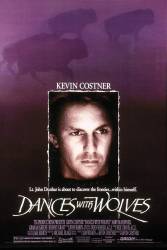Factual error: In a scene where Dunbar is at the fort and a Henry 1860 rifle is lying on a firing port, there appears to be a long cartridge similar to 45/70 or.50 Govt with the rifle. The Henry 1860 rifle at the time used .44 Henry cartridges which were significantly shorter. (00:41:55)
Factual error: The Henry Repeating Rifle seen in 1865 is impossible, because it's the "King's Patent Henry Rifle" which wasn't out until 1866. The original Henry had a loading tube under the barrel, not one on the side of the breech. Plus the ammo used is the larger, more modern rounds.
Factual error: When Lt. Dunbar is preparing for his meeting with the Indians, you can see the rubber sole of his boot as he is putting it on. There is also a stamped logo on the boot heel. Rubber bottomed boots did not exist during the Civil War.
Suggested correction: True enough officially, but it often happened during war or in remote areas or in this case Both, unconvential materials would be used in improvised solutions.
Factual error: We see and hear geese flying overhead toward the end of the film, a sure sign that winter is approaching, but the birds in the shot are sandhill cranes, which do not "honk" like Canada geese.
Factual error: In an opening scene Kevin Costner is seen eating a Delicious Apple, a variety not created until after the Civil War.
Factual error: When Lt. Dunbar gets to the Fort, they show a dove in the rafters. It is a domestic Ringed Turtle-Dove or domesticated Barbary (African Collared) Dove. They likely did not have those doves at the Fort, but rather should have been a Mourning Dove. Rock Doves and chickens were common domestic animals brought for food.
Factual error: When Dunbar saves the native American boy from the charging injured buffalo he jumps off, asks if he's all right then makes two repeated shots from his Henry rifle without cocking the lever. Only special safari guns did that, at a later date.





